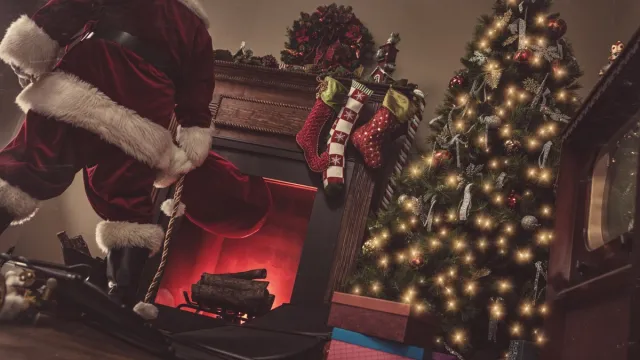Why Does Santa Come Down the Chimney? Here’s the Origin Story

There’s a certain magic that surrounds Santa Claus. He rides in a sleigh led by reindeer, he makes toys at his workshop in the North Pole with the help of elves, and he comes down the chimney to deliver gifts to good children. But why does Santa come down the chimney to leave those presents instead of using simpler means, like the door? We went back more than 500 hundred years in history to find out.
The legend of Santa Claus, who’s based on the Christian bishop Saint Nicholas, dates back centuries, but the modern depiction of Santa—chimney and all—started to take form in the 19th century. Specifically, our current Santa came to life courtesy of Washington Irving. In his 1809 book Knickerbocker’s History of New York, the U.S. writer and historian describes Saint Nicholas as a man who is seen “riding jollily among the tree tops, or over the roofs of the houses, now and then drawing forth magnificent presents from his breeches pockets, and dropping them down the chimneys of his favorites.”
But Irving didn’t get the idea to have Santa drop gifts down chimneys out of thin air. The concept that magical creatures enter homes through chimneys actually comes from the 1400s, when there was a widespread belief—and fear—that witches could pass through solid objects to enter any residence, according to Jeffrey Burton Russell, author of Witchcraft in the Middle Ages.
In 1486, Heinrich Kramer and Jacob Sprenger wrote Malleus Maleficarum, which is considered to be one of the most thorough books on witchcraft. To help ease the public’s anxiety, Kramer and Sprenger wrote that witches instead entered houses through chimneys or windows.
Since then, the chimney has become a common symbol within European folklore, linking the earthly world with the supernatural. In Scottish legend, the brownie is a creature who enters through the chimney and aids in household chores while families are sleeping. In Irish lore, there’s the bodach, an evil creature who slips in through the chimney to kidnap children. And in Italian folklore, there’s La Befana, who rides on a broomstick to deliver candy to good children, entering their homes through chimneys.
As stories were passed down over the centuries, it became common for mythical creatures to enter homes through the chimney—so Irving’s decision to include Santa in the long list of chimney-climbing characters wasn’t so unusual.
And it didn’t take long for Irving’s legend to stick—especially with the help of Clement C. Moore’s 1822 poem “A Visit from Saint Nicholas” (more commonly known as “‘Twas the Night Before Christmas“), which was inspired by Irving’s book. “The stockings were hung by the chimney with care / In hopes that Saint Nicholas soon would be there,” Moore famously wrote of the jolly old figure we know and love today. And for more on the legend of Santa Claus, check out Why Santa Gives Naughty Kids a Lump of Coal on Christmas.